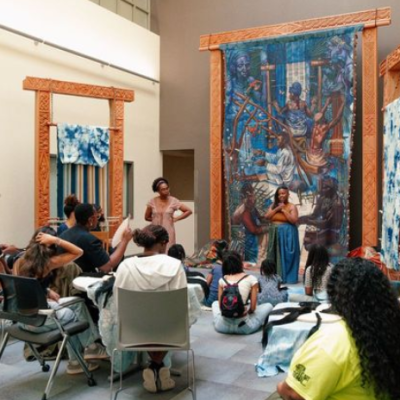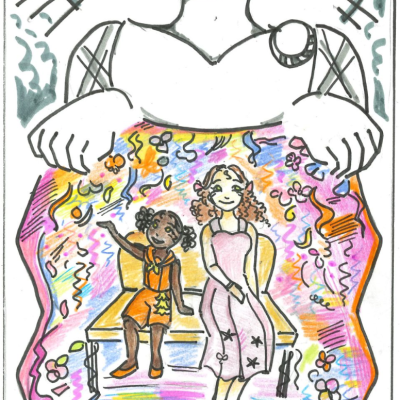Fat Ham: It’s Shakespeare, kind of
Shakespearean plays: a backbone within the industry of modern mediums. Through public interaction — and the critical eye of twenty-first-century consumers — the effect of this English playwright remains far beyond his time. Shakespeare’s enterprise has been a source of awe, inspiration, and even analytical judgment, for centuries. Perhaps the greatest extraction from his vibrant, intricate works, however, is the cultivation of all artists, and the evolution of their creativity. It is through engagement with the Shakespearean craft that one must not only internalize what, exactly, makes it so masterful — but also challenge the components of one’s own media, so as to incorporate into it the strengths of such proficiency. There are countless interpretations of these plays, in countless mediums, with a great portion that brilliantly demonstrate the challenging, but equally fulfilling, process of reimagining Shakespeare. There comes the question: how else does one elevate an already influential work, than by taking one’s own entreating, witty spin? Such encompasses the Off-Broadway production, “Fat Ham.” Written by James Ijames, this play sources the tale of Shakespeare’s “Hamlet” and reflects its vision to a family barbeque in the American South. Much like its counterpart, “Fat Ham” is a journey of exploration. It is a matter of questioning one’s self, one’s kin, and one’s responsibility to the convolution of honor — and discovering, at last, a semblance of fulfillment amongst them. It follows Juicy, the main character who does not fill the shoes of Hamlet, but rather carves his own path — as he is faced with the murder of his father and the recognition that this is not the only horror he must face.
On the most surface of levels, this play fulfills every last distinction one could expect from an enjoyable play — even more so one of Shakespeare’s. The cast is a brilliant embodiment of the work, one that brings such emulation of the human experience to the stage. They cultivate the effortless humor, the ready-to-burst passion, the dread and struggle of interpersonal connection, that this play so strives to press upon its audience. One cannot leave the theater without an eviction of emotion, without an inspiration that lies in the discovery of self, and the bravery, the strength, to that acceptance. From the immersive set design to the gripping performances of this cast, “Fat Ham” cultivates its very own world — nothing is two-dimensional, none of the characters can be summed down to simply an inclination toward love or hate. Viewing this play is simply viewing people in their sphere of the world, showcasing encounters and environments that we ourselves come across each day. When perceiving “Fat Ham,” even upon first glance, one would struggle to have to wonder how this play won itself the Pulitzer Prize.
Analyzing on a deeper note, however, “Fat Ham” is a masterclass in the evolution of creativity, and its symbiotic dynamic with reimagining Shakespeare’s works. Although this play is distinct in and of itself, standing as a category of its own, the suggestion of a retelling is the incorporation of the source material, no matter how sparse, throughout the medium. “Fat Ham” takes an artist’s liberty to such elements, using a spareness on Shakespeare’s quotes and syntax to only further elevate the medium once they are set into motion. Take the portrayal of Juicy, with his dissociation from the world around him: it is fitting, as others put emphasis on the alienation felt between his unique personality and perspective, and that of Southern expectations, that it is Juicy alone who speaks in the traditional Shakespeare lexicon. When experiencing “Fat Ham,” one can’t help but wonder at the vague entrails to “Hamlet,” marveling at the tipped scale — one in favor of all these modern, reenvisioned elements, but seemingly so far from the source material itself. That is, until Juicy is left to his wonderings, inner turmoil, and keen sense of betrayal to self in the natural unfolding of events, and suddenly we are faced with the original play’s flare of existentialism — the grappling slip of sanity, painted next to others so different than oneself.
As Juicy stuns the audience and his companions alike with this showcase of such deep emotion and insight — a perspective so raw and surreal that not one of us can help but recoil, or even lean in closer — when compared to those else wise, we are shown true mastery in a recreation. Also an intriguing, perhaps even surreal, dynamic of the play, is the perpetual shattering of the fourth wall. Juicy communicates with the audience his truths, his anguish and his aspirations, via the textbook mastery of Shakespeare himself: soliloquies, and asides. It achieves much the same as the flare of Shakespearean works, with an effortless expression of emotion and hard truths. Sourced from something so archaic, so sampled from as Shakespeare’s works, “Fat Ham” envisions in a fresh body a lesson we do not often recognize: a reimagination does not inherently suggest bland, cookie-cutter sourcing, but rather a potential for something entirely unseen and unexpected. In fact, this is where the true creativity and mastery emerges — a lens of honest truth from the mouths of those who bring life to this retelling. Such modest sampling does not make it any less real, but rather only highlights the emotion and strife built within its run. The true lesson can be found as this: the mastery of art, of connecting with an audience, is to cultivate a genuine, raw emotion — and a fresh lens in which it is brought from.










